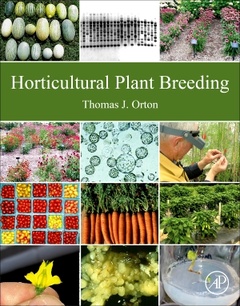Description
Horticultural Plant Breeding
Authors: Orton Thomas J., Orton Thomas J.
Language: English
Subjects for Horticultural Plant Breeding:
122.46 €
In Print (Delivery period: 14 days).
Add to cart410 p. · 21.4x27.6 cm · Paperback
Description
/li>Contents
/li>Readership
/li>Biography
/li>Comment
/li>
Horticultural Plant Breeding is a complete and comprehensive resource for the development of new cultivars or clones of horticultural crops. It covers the basic theories that underpin plant breeding and applies Mendelian, quantitative and population inheritance practices in smaller populations where the individual plant has high value. Specific traditional breeding methods are also covered, with an emphasis on how these methods are adapted for horticultural species. In addition, the integration of biotechnologies with traditional breeding methodologies is explored, with an emphasis on specific applications for fruits, vegetables and ornamental crop species. Presented in focused sections, Horticultural Plant Breeding addresses historical perspectives and context, and genetics as a critical foundation of plant breeding. It highlights treatments of the various components of breeding programs, such as breeding objectives, germplasm, population engineering, mating systems, enhanced selection methods, established breeding methods applicable to inbreeding and outcrossing situations, and post-breeding activities.
Section 1. Elements and Underpinnings of Plant BreedingIntroduction to Section 11. Introduction2. The Context of Plant Breeding3. Review of Genetics (From the Perspective of a Plant Breeder)4. Engineered Population Structures5. Mass Selection and the Basic Plant Breeding Algorithm6. Breeding Objectives7. Germplasm and Genetic Variability 8. Enhancement of Germplasm9. Improvement of Selection Effectiveness 10. Natural Mating Systems and Controlled Mating 11. Cultivar Testing and Seed Production 12. Protection of Proprietary Plant Germplasm
Section 2. Breeding MethodsIntroduction to Section 213. The Pedigree Method 14. Other Breeding Methods for Self Pollinated Plant Species15. Breeding Methods for Outcrossing Plant Species: I. History of Corn Breeding and Open Pollinated Populations16. Breeding Methods for Outcrossing Plant Species: II. Hybrid Cultivars 17. Breeding Methods for Outcrossing Plant Species: III. Asexual Propagation 18. The Backcross Method 19. Breeding for Disease and Insect Resistance
- Provides a complete and comprehensive resource for those involved in the development of new cultivars or clones of horticultural crops
- Guides readers to the most appropriate breeding strategy including potential integration of traditional and biotechnology strategies that will best achieve a cost-effective outcome
- Will include access to 20 narrated slide sets to facilitate additional understanding




